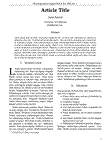Resultados de búsqueda - (taxonomicicica OR ((taxonomy OR (taxonomico OR taxonomic)) OR (taxonomicia OR taxonomyoyyic)))
Materias dentro de su búsqueda.
Materias dentro de su búsqueda.
- Mexico 2
- México 2
- Taxonomía 2
- biodiversidad 2
- conservation 2
- Alligator gar 1
- Amphibians 1
- Anfibios 1
- Annelida 1
- Aplicación móvil 1
- Atractosteus spatula 1
- Autorregulación 1
- Barcodes of Life 1
- Biodiversity 1
- Catán 1
- Colecciones biológicas 1
- Community conservation 1
- Conservación 1
- Código de barra de la vida 1
- Derechos humanos 1
- Desarrollo Instruccional 1
- Diseño Instruccional 1
- Echinodermata 1
- Epifauna de plásticos a la deriva 1
- Epifauna of drifting plastics 1
- Ethnoherpetology 1
- Ethnoherpetología 1
- Financial Innovation 1
- Financiamiento 1
- Golfo de California 1
-
61
Characterization of lignocellulolytic activities from fungi isolated from the deep-sea sponge Stelletta normani
Publicado 2017“…Following screening of fourteen fungi isolated from the deep-sea sponge Stelletta normani sampled at a depth of 751 metres, three halotolerant strains (TS2, TS11 and TS12) were identified which displayed high CMCase and xylanase activities. Molecular based taxonomic approaches identified these strains as Cadophora sp. …”
Enlace del recurso
Artículo -
62
High diversity and suggested endemicity of culturable Actinobacteria in an extremely oligotrophic desert oasis
Publicado 2017“…Phylogenetic reconstructions were performed to analyze OTUs clustering and taxonomic identification of the isolates in an evolutionary context, using validated type species of Streptomyces from previously phylogenies as a reference. …”
Enlace del recurso
Artículo -
63
Discovery of a Novel Polyomavirus in Acute Diarrheal Samples from Children
Publicado 2012“…The ,5.0 kB viral genome exhibits little overall homology (,46% amino acid identity) to known polyomaviruses, and, due to phylogenetic variation among its individual proteins, cannot be placed in any existing taxonomic group. PCR-based screening detected MXPyV in 28 of 834 (3.4%) fecal samples collected from California, Mexico, and Chile, and 1 of 136 (0.74%) of respiratory samples from Mexico, but not in blood or urine samples from immunocompromised patients. …”
Enlace del recurso
Artículo -
64
Carbohydrate-free peach (prunus persica) and plum (prunus domestica) juice affects fecal microbial ecology in an obese animal model
Publicado 2014“…Over 1,500 different Operational Taxonomic Units at 97% similarity were detected in all rats. …”
Enlace del recurso
Artículo -
65
Characterization of lignocellulolytic activities from fungi isolated from the deep-sea sponge Stelletta normani
Publicado 2017“…Following screening of fourteen fungi isolated from the deep-sea sponge Stelletta normani sampled at a depth of 751 metres, three halotolerant strains (TS2, TS11 and TS12) were identified which displayed high CMCase and xylanase activities. Molecular based taxonomic approaches identified these strains as Cadophora sp. …”
Enlace del recurso
Artículo -
66
High diversity and suggested endemicity of culturable Actinobacteria in an extremely oligotrophic desert oasis
Publicado 2017“…Phylogenetic reconstructions were performed to analyze OTUs clustering and taxonomic identification of the isolates in an evolutionary context, using validated type species of Streptomyces from previously phylogenies as a reference. …”
Enlace del recurso
Artículo -
67
Carbohydrate-Free Peach (Prunus persica) and Plum (Prunus salicina) [corrected] Juice Affects Fecal Microbial Ecology in an Obese Animal Model.
Publicado 2014“…Over 1,500 different Operational Taxonomic Units at 97% similarity were detected in all rats. …”
Enlace del recurso
Artículo -
68
Sistemática y distribución geográfica de la familia Capitellidae Grube, 1862 (Annelida: Polychaeta) del noroeste de México
Publicado 2008“…The need to conduct taxonomical review of the Capitellidae family has been considered by various authors, it is evidenced that it taxonomical status is not well established, because they are based on their number of thoracic segments with capillary setae, which suffer modification during the development of the organisms. …”
Enlace del recurso
Tesis -
69
Sistemática y distribución geográfica de la familia Capitellidae Grube, 1862 (Annelida: Polychaeta) del noroeste de México
Publicado 2008“…The need to conduct taxonomical review of the Capitellidae family has been considered by various authors, it is evidenced that it taxonomical status is not well established, because they are based on their number of thoracic segments with capillary setae, which suffer modification during the development of the organisms. …”
Enlace del recurso
Tesis -
70
Influence of whole-wheat consumption on fecal microbial community structure of obese diabetic mice
Publicado 2016“…Almost 9,000 different bacterial species (Operational Taxonomic Units at 97% similarity) were detected in all mice but the bacterial diversity (number of OTUs) did not differ among the treatment groups. …”
Enlace del recurso
Artículo -
71
Biología y ecología de la merluza bajacaliforniana, Merluccius angustimanus Garman, 1899, en la costa occidental de baja california sur, México
Publicado 2005“…It is concluded that M. angustimanus is taxonomically and ecologically discernable from M. productus, a hake that shares the northern range of its distribution. …”
Enlace del recurso
Tesis -
72
Biología y ecología de la merluza bajacaliforniana, Merluccius angustimanus Garman, 1899, en la costa occidental de baja california sur, México
Publicado 2005“…It is concluded that M. angustimanus is taxonomically and ecologically discernable from M. productus, a hake that shares the northern range of its distribution. …”
Enlace del recurso
Tesis -
73
Interacciones alimentarias de depredadores en el noroeste del estado de Sonora
Publicado 2009“…Los contenidos se clasificaron en los grupos taxonómicos siguientes: lagomorfos, roedores, artiodactilos, reptiles, aves y plantas. …”
Enlace del recurso
Tesis -
74
Interacciones alimentarias de depredadores en el noroeste del estado de Sonora
Publicado 2009“…Los contenidos se clasificaron en los grupos taxonómicos siguientes: lagomorfos, roedores, artiodactilos, reptiles, aves y plantas. …”
Enlace del recurso
Tesis -
75
Insectos asociados a biomodelos simulando cuatro condiciones de hallazgo de cadáveres.
Publicado 2018“…The general objective of the study was to generate taxonomic information of necrophagous insects in biomodels (Sus scrofa) simulating conditions of corpses exposed to the weather, submerged in water, encased in wood and in plastic bags. …”
Enlace del recurso
Tesis -
76
Microbiota gastrointestinal y síndrome de intestino irritable
Publicado 2014“…The differences in sequencing of these hypervariable regions make it possible to taxonomically identify the bacteria present in study samples (for example, in stools and intestinal mucosa).3 The «rrs» gene, also known as 16S ribosomal DNA or 16S rDNA, as mentioned in table 3 of our article, encodes 16S rRNA. …”
Enlace del recurso
Artículo -
77
Insectos asociados a biomodelos simulando cuatro condiciones de hallazgo de cadáveres.
Publicado 2018“…The general objective of the study was to generate taxonomic information of necrophagous insects in biomodels (Sus scrofa) simulating conditions of corpses exposed to the weather, submerged in water, encased in wood and in plastic bags. …”
Enlace del recurso
Tesis -
78
Distribución, abundancia, diversidad y atributos bioecológicos de especies de chrysopidae (neuroptera) asociadas a frutales del centro y norte de México
Publicado 2007“…La familia Chrysopidae (Neuroptera) integra una gran cantidad de especies que exhiben hábitos arbóreos, las cuales podrían ser de gran importancia en el control de plagas en los diversos árboles frutales de México; sin embargo, el potencial de estos insectos benéficos ha sido ignorado o subestimado debido a la escasa disponibilidad de estudios taxonómicos de este grupo en el país. El presente estudio fue realizado con los objetivos del identificar y determinar la distribución, abundancia, diversidad y bioecología de especies de Chrysopidae asociadas a frutales del centro y norte de México, para contribuir en la protección, conservación y aprovechamiento de estos agentes de control biológico en el país. …”
Enlace del recurso
Tesis -
79
Distribución, abundancia, diversidad y atributos bioecológicos de especies de chrysopidae (neuroptera) asociadas a frutales del centro y norte de México
Publicado 2007“…La familia Chrysopidae (Neuroptera) integra una gran cantidad de especies que exhiben hábitos arbóreos, las cuales podrían ser de gran importancia en el control de plagas en los diversos árboles frutales de México; sin embargo, el potencial de estos insectos benéficos ha sido ignorado o subestimado debido a la escasa disponibilidad de estudios taxonómicos de este grupo en el país. El presente estudio fue realizado con los objetivos del identificar y determinar la distribución, abundancia, diversidad y bioecología de especies de Chrysopidae asociadas a frutales del centro y norte de México, para contribuir en la protección, conservación y aprovechamiento de estos agentes de control biológico en el país. …”
Enlace del recurso
Tesis -
80


